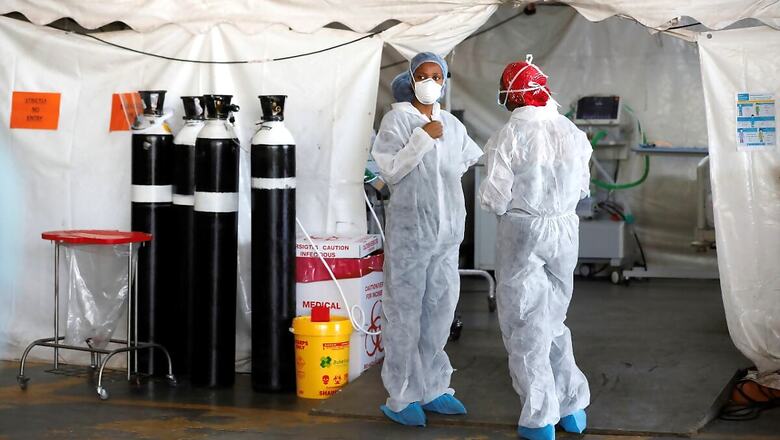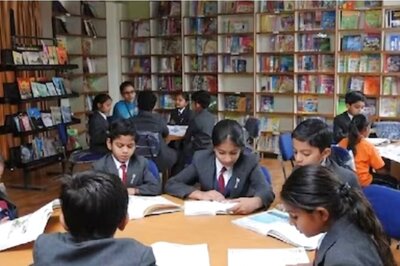
views
An unsuspecting world woke to the advent of 2020 with the excitement of a new year’s dawn, amplified by the charm of its resonant numeric. There was little inkling that the year that just ended had plotted to memorialise itself through a new respiratory virus that would shake the world with a disease named Covid-19. Even as 2020 paid a high price, in global health and economy, 2021 too is still feeling the sharp sting of the virus.
India’s experience has been different from what many other parts of the world experienced, though by no means unique as our South Asian neighbours too had a similar experience. When the pandemic entered India, predictions were made of catastrophic losses from a tidal wave of infected cases flooding an inadequate health system and millions of deaths occurring because of the inability to stem the tide. Mathematical models spelt a dire destiny. However, 2020 ended reassuringly with the epidemic clearly on a downward trend and 2021 began with a puzzled world looking for explanations of the relatively benign Indian experience.
The novel coronavirus landed in India on January 30, 2020, with a group of students returning from Wuhan. Over the next two months, some more cases were reported, mostly related to religious, social or political mass gatherings which sparked superspreader transmission among attendees. Clinical screening of incoming international passengers commenced in mid-January and was progressively scaled up till March. Simultaneously, Indian nationals resident abroad were evacuated through organised airlifts. On March 11, guidelines for use of masks were issued and the central government invoked the Epidemic Diseases Act (1897) and Disaster Management Act (2005) to lead the countrywide containment efforts.
The implementation of a rigorous nationwide lockdown commenced on the midnight of March 24-25. Its sudden imposition caused hardship to many sections of the people, most of all to migrant families in cities who could not travel back to their villages despite loss of livelihoods and shelter in the altered urban environment. Their painful trek back home was a poignant reminder that public health measures must accommodate a humane social perspective. The lockdown, however, gave much needed mind space and time to prepare the health system and other administrative agencies to gather more resources and implement a well-coordinated national response.
By mid-March, horrifying media images were emerging of overcrowded hospitals and piling dead bodies across Europe and the USA. These were accompanied by alarming predictions of imminent doom for India, in the form of a ferocious tidal wave of cases and millions of deaths, by modellers who extrapolated Western experience to the Indian population. Important variables, like the fact that two-thirds of India is rural, were not considered in such models. However, that set in motion a media frenzy which sparked public panic.
Public health capacity was limited and the neglect of urban primary care health services showed up in patchy contact tracing which was tasked to the police in many areas. Shortages in testing kits, hospital beds and ventilators became subjects of trenchant criticism. Breakdown of global supply chains posed threats to the availability of medical equipment and active pharmaceutical ingredients. This resulted in a concerted bid to manufacture and mobilise domestic resources, with a call for self-reliance (atmanirbhar). From masks and testing kits to ventilators and contact tracing apps, India found new energy in multiple groups who rallied to support the central and state governments. They ranged from private industry to women’s cooperatives.
Even as agricultural harvesting operations were permitted from mid-April, strict lockdown continued across the country till May 3 and later extended in stages till May 18 and May 31 with some concessions to people movement. Progressive relaxation (staged unlocking) was implemented thereafter. By mid-June, most of the country had emerged from the lockdown, though some states and cities with high transmission rates continued rigorous restrictions for longer periods. Schools and colleges continued to be closed and travel was restricted in response to the state of the pandemic within and outside India. Working from home became the new norm. Saving lives and livelihoods were sometimes debated as competing priorities but generally found accommodation in a policy framework that accorded importance to both as the lockdown lifted.
As movement of people increased, both within urban areas and from there to rural areas, the virus travelled with people and celebrated with crowds. Cases rose sharply, daily death counts mounted and hospitals were besieged by families beseeching admissions for their loved ones. Global media reported India’s swift rise to the number 2 spot, without taking into account the fact of India’s huge population. Reporting cases and deaths per million population, where India was well below many countries, was an infrequent occurrence. When this was pointed out to global observers, the usual response was to suggest that India was undercounting the cases and deaths. The mix of multiple testing methods boosted testing numbers but detracted from accuracy because of the low sensitivity of rapid diagnostic tests. Daily death counts provided a better tracker, despite some undercounting, as the variability in counting methods was less subject to variation over time.
Public health measures, related to Covid-appropriate behaviour, continued to be prescribed and practiced. Despite varying levels of adherence in different parts of the country, these helped to curtail transmission. By mid- September, daily case counts started declining at the national level and daily death counts too started falling by end-September. While there was variability across districts, the aggregate national trend of decline continued steadily.
Serological surveys of antibodies against the virus commenced from July. Conducted by different agencies, they ranged from quasi-national surveys conducted by central government agencies, state or city level surveys conducted by state government agencies and some state or city level surveys conducted by national and international academic institutions. Despite great variation in the proportion of seropositive population reported, the surveys uniformly revealed much higher levels of virus exposed individuals than identified by the molecular or rapid antigen tests for virus detection. It appeared that many of the virus exposed individuals had asymptomatic or ‘too mild to report’ clinical effects. It is not clear whether this is mainly because of India’s younger demographic profile or also because of non-specific immunity built up through prior exposure to other corona and non-corona viruses.
The rural population of India is less likely to see rapid or extensive transmission. There is less crowd density, better ventilated housing, work is mostly in airy fields or open areas of homes and lower levels of comorbidities result in low clinical severity which in turn leads to lower transmission. States like Kerala, where urban-rural differentiation is minimal, may see considerable rural transmission but the highly rural hinterland has protection against rapid or extensive transmission.
Herd immunity has been frequently mooted, both as a control strategy and as an explanation for the declining rates. The most recent national survey of ICMR, completed in January 2021, revealed a national prevalence of 21%, well below any internationally discussed herd immunity threshold (60-80%). Other than a few urban pockets, most of India has not reached close to a plausible herd immunity threshold. Herd immunity is also a population attribute, not an individual attribute. Immune individuals, in large numbers, block transmission of the virus to others. Non-immune individuals in any group which has collectively crossed the threshold are still at risk when they visit another area where that threshold has not been crossed and transmission is still active. That is because they are no longer shielded by a protective cordon of immune persons.
Younger age of the population also resulted in a lower population death rate. Population aged over 65 years is lower in India (6%), compared to Italy (23%), France (20%) and the USA (16%). As the pandemic progressed, treatment protocols too improved and case-fatality rates declined. Ventilator usage was sparse, prone positions and high-flow oxygen proved beneficial in severe cases and home care became the norm for mild and asymptomatic infections. Public and private sectors both responded, with the former leading the way, and temporary infrastructure was speedily created for quarantining of exposed persons and isolation of diagnosed cases.
Laboratory capacity was expanded across the country, for viral diagnosis, serology, genomic screening for mutants and development of vaccines. Manufacture of vaccines, whether domestically developed or internationally designed and licensed for production in India, moved on fast track, while clinical trials followed. Science and public health received political attention and public acclaim, even as medical care providers were hailed as Covid warriors.
While a combination of many factors enabled India to end a year of battle with Covid-19 on an assured note of gaining the upper hand, there is no room for complacency. A more infectious form of the virus, in the form of a mutant from the UK (B.1.1.7), has recently arrived with international travellers and is already making its presence felt. Vaccination of essential workers is in progress and will soon extend to persons who are vulnerable because of older age (above 50 years) or comorbidities which increase the risk of severe disease and adverse outcomes. Nationwide rollout will, however, take several months. Till we are reassured that there is no resurgence of the epidemic in India and the global situation too has reached a comforting level of control, public health vigilance and personal protection measures have to continue. As in cricket, we may be in a winning position now but cannot claim victory till the virus has lost its last wicket.
Read all the Latest News, Breaking News and Coronavirus News here




















Comments
0 comment